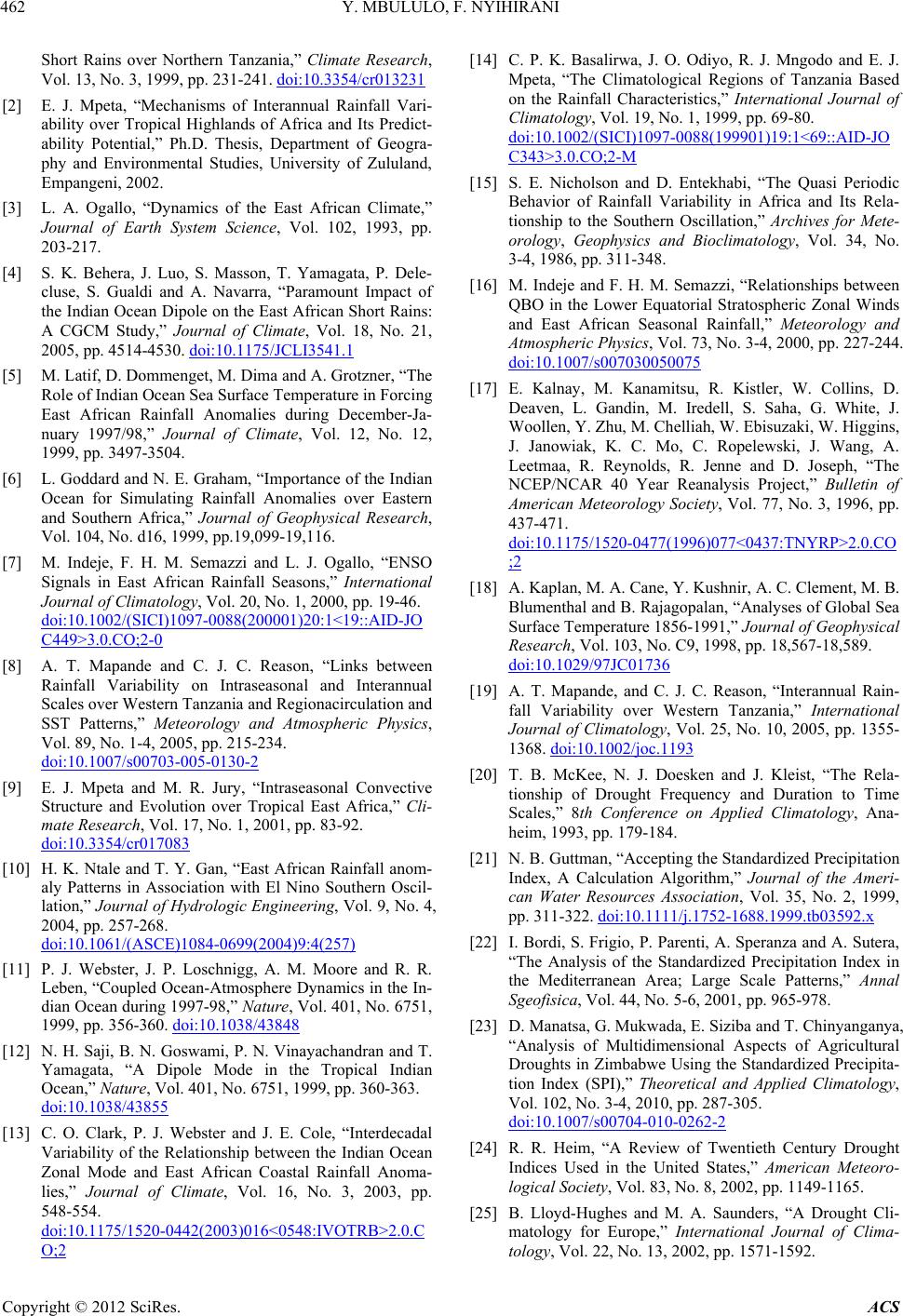
Y. MBULULO, F. NYIHIRANI
462
Short Rains over Northern Tanzania,” Climate Research,
Vol. 13, No. 3, 1999, pp. 231-241. doi:10.3354/cr013231
[2] E. J. Mpeta, “Mechanisms of Interannual Rainfall Vari-
ability over Tropical Highlands of Africa and Its Predict-
ability Potential,” Ph.D. Thesis, Department of Geogra-
phy and Environmental Studies, University of Zululand,
Empangeni, 2002.
[3] L. A. Ogallo, “Dynamics of the East African Climate,”
Journal of Earth System Science, Vol. 102, 1993, pp.
203-217.
[4] S. K. Behera, J. Luo, S. Masson, T. Yamagata, P. Dele-
cluse, S. Gualdi and A. Navarra, “Paramount Impact of
the Indian Ocean Dipole on the East African Short Rains:
A CGCM Study,” Journal of Climate, Vol. 18, No. 21,
2005, pp. 4514-4530. doi:10.1175/JCLI3541.1
[5] M. Latif, D. Dommenget, M. Dima and A. Grotzner, “The
Role of Indian Ocean Sea Surface Temperature in Forcing
East African Rainfall Anomalies during December-Ja-
nuary 1997/98,” Journal of Climate, Vol. 12, No. 12,
1999, pp. 3497-3504.
[6] L. Goddard and N. E. Graham, “Importance of the Indian
Ocean for Simulating Rainfall Anomalies over Eastern
and Southern Africa,” Journal of Geophysical Research,
Vol. 104, No. d16, 1999, pp.19,099-19,116.
[7] M. Indeje, F. H. M. Semazzi and L. J. Ogallo, “ENSO
Signals in East African Rainfall Seasons,” International
Journal of Climatology, Vol. 20, No. 1, 2000, pp. 19-46.
doi:10.1002/(SICI)1097-0088(200001)20:1<19::AID-JO
C449>3.0.CO;2-0
[8] A. T. Mapande and C. J. C. Reason, “Links between
Rainfall Variability on Intraseasonal and Interannual
Scales over Western Tanzania and Regionacirculation and
SST Patterns,” Meteorology and Atmospheric Physics,
Vol. 89, No. 1-4, 2005, pp. 215-234.
doi:10.1007/s00703-005-0130-2
[9] E. J. Mpeta and M. R. Jury, “Intraseasonal Convective
Structure and Evolution over Tropical East Africa,” Cli-
mate Research, Vol. 17, No. 1, 2001, pp. 83-92.
doi:10.3354/cr017083
[10] H. K. Ntale and T. Y. Gan, “East African Rainfall anom-
aly Patterns in Association with El Nino Southern Oscil-
lation,” Journal of Hydrologic Engineering, Vol. 9, No. 4,
2004, pp. 257-268.
doi:10.1061/(ASCE)1084-0699(2004)9:4(257)
[11] P. J. Webster, J. P. Loschnigg, A. M. Moore and R. R.
Leben, “Coupled Ocean-Atmosphere Dynamics in the In-
dian Ocean during 1997-98,” Nature, Vol. 401, No. 6751,
1999, pp. 356-360. doi:10.1038/43848
[12] N. H. Saji, B. N. Goswami, P. N. Vinayachandran and T.
Yamagata, “A Dipole Mode in the Tropical Indian
Ocean,” Nature, Vol. 401, No. 6751, 1999, pp. 360-363.
doi:10.1038/43855
[13] C. O. Clark, P. J. Webster and J. E. Cole, “Interdecadal
Variability of the Relationship between the Indian Ocean
Zonal Mode and East African Coastal Rainfall Anoma-
lies,” Journal of Climate, Vol. 16, No. 3, 2003, pp.
548-554.
doi:10.1175/1520-0442(2003)016<0548:IVOTRB>2.0.C
O;2
[14] C. P. K. Basalirwa, J. O. Odiyo, R. J. Mngodo and E. J.
Mpeta, “The Climatological Regions of Tanzania Based
on the Rainfall Characteristics,” International Journal of
Climatology, Vol. 19, No. 1, 1999, pp. 69-80.
doi:10.1002/(SICI)1097-0088(199901)19:1<69::AID-JO
C343>3.0.CO;2-M
[15] S. E. Nicholson and D. Entekhabi, “The Quasi Periodic
Behavior of Rainfall Variability in Africa and Its Rela-
tionship to the Southern Oscillation,” Archives for Mete-
orology, Geophysics and Bioclimatology, Vol. 34, No.
3-4, 1986, pp. 311-348.
[16] M. Indeje and F. H. M. Semazzi, “Relationships between
QBO in the Lower Equatorial Stratospheric Zonal Winds
and East African Seasonal Rainfall,” Meteorology and
Atmospheric Physics, Vol. 73, No. 3-4, 2000, pp. 227-244.
doi:10.1007/s007030050075
[17] E. Kalnay, M. Kanamitsu, R. Kistler, W. Collins, D.
Deaven, L. Gandin, M. Iredell, S. Saha, G. White, J.
Woollen, Y. Zhu, M. Chelliah, W. Ebisuzaki, W. Higgins,
J. Janowiak, K. C. Mo, C. Ropelewski, J. Wang, A.
Leetmaa, R. Reynolds, R. Jenne and D. Joseph, “The
NCEP/NCAR 40 Year Reanalysis Project,” Bulletin of
American Meteorology Society, Vol. 77, No. 3, 1996, pp.
437-471.
doi:10.1175/1520-0477(1996)077<0437:TNYRP>2.0.CO
;2
[18] A. Kaplan, M. A. Cane, Y. Kushnir, A. C. Clement, M. B.
Blumenthal and B. Rajagopalan, “Analyses of Global Sea
Surface Temperature 1856-1991,” Journal of Geophysical
Research, Vol. 103, No. C9, 1998, pp. 18,567-18,589.
doi:10.1029/97JC01736
[19] A. T. Mapande, and C. J. C. Reason, “Interannual Rain-
fall Variability over Western Tanzania,” International
Journal of Climatology, Vol. 25, No. 10, 2005, pp. 1355-
1368. doi:10.1002/joc.1193
[20] T. B. McKee, N. J. Doesken and J. Kleist, “The Rela-
tionship of Drought Frequency and Duration to Time
Scales,” 8th Conference on Applied Climatology, Ana-
heim, 1993, pp. 179-184.
[21] N. B. Guttman, “Accepting the Standardized Precipitation
Index, A Calculation Algorithm,” Journal of the Ameri-
can Water Resources Association, Vol. 35, No. 2, 1999,
pp. 311-322. doi:10.1111/j.1752-1688.1999.tb03592.x
[22] I. Bordi, S. Frigio, P. Parenti, A. Speranza and A. Sutera,
“The Analysis of the Standardized Precipitation Index in
the Mediterranean Area; Large Scale Patterns,” Annal
Sgeofisica, Vol. 44, No. 5-6, 2001, pp. 965-978.
[23] D. Manatsa, G. Mukwada, E. Siziba and T. Chinyanganya,
“Analysis of Multidimensional Aspects of Agricultural
Droughts in Zimbabwe Using the Standardized Precipita-
tion Index (SPI),” Theoretical and Applied Climatology,
Vol. 102, No. 3-4, 2010, pp. 287-305.
doi:10.1007/s00704-010-0262-2
[24] R. R. Heim, “A Review of Twentieth Century Drought
Indices Used in the United States,” American Meteoro-
logical Society, Vol. 83, No. 8, 2002, pp. 1149-1165.
[25] B. Lloyd-Hughes and M. A. Saunders, “A Drought Cli-
matology for Europe,” International Journal of Clima-
tology, Vol. 22, No. 13, 2002, pp. 1571-1592.
Copyright © 2012 SciRes. ACS